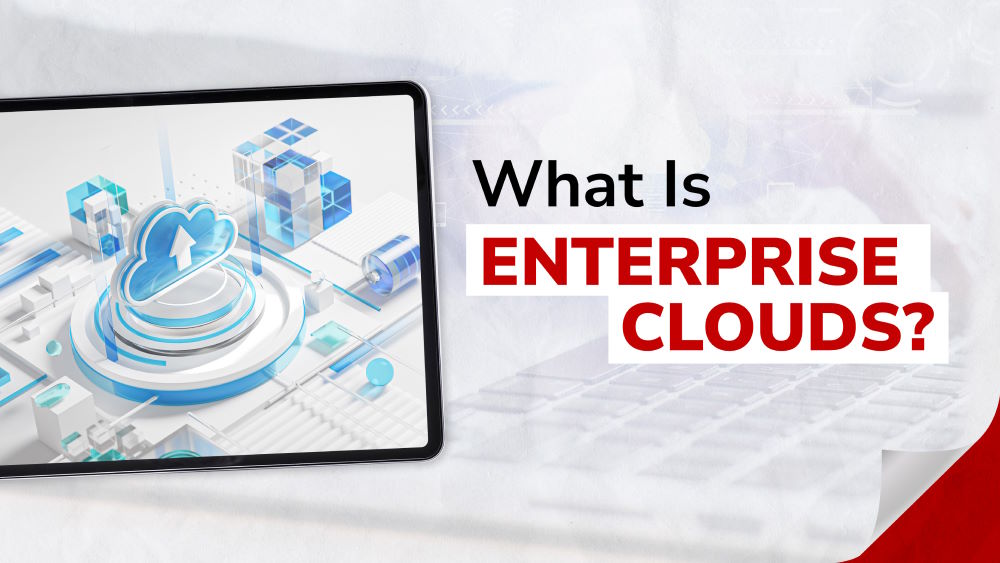An Introduction to Enterprise Cloud Computing

Content Map
More chaptersLook where we are standing, the world of technology has changed drastically during the past decade, and businesses have had to keep up with the fast pace of digital transformation. One of the most significant changes has been the shift to cloud technology.
The rapid evolution of enterprise cloud computing has reshaped the way businesses operate, offering unprecedented opportunities for growth and innovation. The benefits of cloud adoption have opened the eyes of corporate leaders, and many enterprise organizations are now eager to sink money into becoming “cloud-native.” Statistics indicate that 80% of companies invest over $1.2 million in the cloud per year, and 37% of large corporations exceed the annual expenses of $12 million on cloud technology.
In recent years, we have witnessed all-sized companies in a variety of sectors adopt an enterprise cloud platform to streamline many of their operations, reduce costs, and accelerate growth. In recent years, we have witnessed companies across industries have embraced cloud technologies to streamline much of their operations, reduce costs, and accelerate growth.
It’s essential to understand the fundamentals of enterprise cloud computing if you want to capitalize on the promising opportunities that cloud computing presents.
What Is Enterprise Cloud?
Over the past two decades, the concept of the enterprise cloud has evolved a lot from its inception. The term “cloud computing” was brought to the mainstream by Amazon Web Service in 2006 –2007 as a way of renting virtualized computing resources in an infinitely scalable environment.
Let’s recap. Cloud computing is the terminology referring to a technology that enables users to access and utilize IT resources, such as data storage, process power, and software applications, all over the internet. Thanks to cloud services, IT infrastructure is no longer physically located on a user’s device or local server but instead is hosted and managed on a remote data center empowered by a cloud provider. Moving to the cloud environment enables users to scale and adjust their computing needs dynamically without investing in expensive hardware or infrastructure.
Enterprise cloud computing is not as complex or confusing as it sounds. At its core, the enterprise cloud is simply implementing cloud infrastructure in a business setting. It is an industry-level approach to leveraging cloud computing technologies for the purpose of achieving business objectives. It can be as simple as using a cloud-based data storage system, or it can involve more complex tasks like automating processes and streamlining operations. Whatever the use case may be, enterprise cloud solutions are designed to bring an organization into the digital era with ease.
On the cloud journey of any enterprise or company, there will be challenges, especially in the very first stages of implementation, but it is worth considering that the advantages far outweigh the risks. Therefore, finding the right partners for cloud computing services is of paramount importance. Currently, some of the renowned enterprise cloud service providers are Amazon Web Services (AWS), Microsoft Azure, Google Cloud Platform (GCP), IBM Cloud, Oracle Cloud Infrastructure (OCI), and more. Despite the wide range of options, business owners must select the best cloud vendor based on their needs as well as the security, scalability, and functionality offered.
Types of Enterprise Cloud Architecture

Enterprise cloud computing blends different architectures (distributed, hybrid, private, and public clouds) into one flexible, unified IT environment. Businesses can choose any combination of architectures to match their specific use cases, workloads, and security needs.
Public Cloud
Public clouds are “shared” environments that allow multiple users to simultaneously access virtualized data centers where cloud infrastructure and services are monitored and maintained by a third-party provider. Public cloud services offer enterprises cost-effective scalability and flexibility as they are designed to scale up dynamically or down to meet the ever-changing needs of an organization for data storage, networking, analytics, machine learning, containerization, application development, and more.
The public cloud model is also budget-friendly, as business owners can pay per use for the resources they consume, making it easier to manage their IT budgets. Moreover, public clouds are highly secure and equipped with state-of-the-art security features. However, this architecture by public cloud providers is limited in terms of customization and control.
Private Cloud
A private cloud refers to a single-tenant environment where resources (hardware infrastructure and software components) are dedicated to an organization. The noticeable difference between public and private clouds is that with private cloud architectures, only verified users have exclusive access to their IT infrastructure and data. With this model, an organization can host its own private cloud infrastructure on-premises – in-house private cloud – or in a data center owned by a managed service provider.
Private cloud solutions give businesses greater control over their enterprise cloud systems as they can shape the design and features according to their needs. Private clouds are also more secure than public environments due to an extra layer of security for single-tenant network models. The downside of private clouds is that they are relatively expensive as organizations bear the cost of procuring, setting up, and maintaining their IT infrastructure. Not to mention that enterprise cloud servers and data storage demand expandable space to accommodate more resources in time, which consumes more budget.
That’s the reason why more companies resort to outsourcing cloud deployment to a managed service provider who will handle all the complexities around private cloud setup and maintenance.
Hybrid Cloud
This is a cloud computing model that combines the best of both worlds – public and private clouds. The hybrid cloud model enables a more dynamic environment wherein businesses can move workloads between various types of architectures to suit their needs at a given time.
The combination allows enterprises to secure their sensitive data with the control and security of private clouds while leveraging the cost-effectiveness and scalability of public clouds. Furthermore, with the hybrid cloud strategy, organizations can keep their legacy systems while staying relevant with the agility and scalability of the cloud platforms.
The primary benefit of hybrid clouds is that they offer greater flexibility in terms of resource management and data migration, which is often fraught with difficulties. However, this type of enterprise cloud infrastructure requires more advanced skills for maintenance and monitoring, which makes it more expensive than public and private cloud solutions. Moreover, the security of hybrid clouds may be at risk if not managed properly, as each cloud type has different levels of security.
Multi-Cloud
This is an enterprise cloud model in which organizations can utilize two or more cloud platforms and services from different vendors. The multi-cloud gives businesses the freedom and flexibility to choose as well as mix and match multiple cloud services into one environment for greater flexibility, scalability, and cost savings.
By adopting a multi-cloud strategy, organizations can avoid vendor lock-in, optimize costs, and leverage the unique features and capabilities offered by each cloud provider. Additionally, it enhances security and risk management by spreading data and workloads across different platforms, reducing the impact of potential outages or cyber-attacks on a single provider.
The downside of this type of architecture is that it requires proper management and coordination among multiple vendors for successful integration, which can be challenging. Furthermore, there is a risk of vendor lock-in, which means that if a business decides to move its resources to another cloud provider or platform, the associated costs might be high.
Distributed Cloud
Distributed cloud architectures are characterized by the decentralization of cloud services and applications to edge locations. This model reduces latency in data transmission, as it brings computing resources closer to users for faster access. Furthermore, it permits the execution of data-intensive tasks without relying on distant centralized servers. The distributed cloud is ideal for highly secure workloads that must be handled in a secure and compliant manner.
On the other hand, distributed cloud systems require a complex integration of different components to function correctly, which can be costly for organizations. Moreover, it is difficult to manage the security of multiple edge locations as they are oftentimes located in remote areas with limited access.
Common Cloud Computing Services
As enterprise cloud development progresses, there come various types of cloud services. These services focus on different aspects of the cloud environment and are used for specific requirements like storage and networking. Let’s take a look at the different cloud services available today.
Infrastructure as a Service (IaaS)
This is a cloud computing service that offers resources such as servers, storage, and networking with the virtualization of physical IT infrastructure components. The aim is to reduce the cost of procuring hardware, setting up an on-premises data center, and running maintenance operations. IaaS also provides businesses with scalability for their workload because they can expand their IT resources on demand.
Platform-as-a-Service (PaaS)
This type of cloud service provides businesses with a fully managed environment to create, develop, deploy, and manage applications without worrying about underlying infrastructure components such as hardware or operating system maintenance. It offers an integrated development toolchain for faster application deployment and helps reduce development costs.
Software-as-a-Service (SaaS)
This cloud computing service enables businesses to access, use, and manage applications through the network without having to install or maintain any hardware components. SaaS provides users with a fully managed environment for their business needs and eliminates the need for upfront investments in software licenses.
Function-as-a-Service (FaaS)
This is a serverless cloud computing service that manages the entire lifecycle of an application from development to deployment and execution. FaaS allows developers to create applications by assembling pieces of code into functions that can run independently without worrying about managing underlying infrastructure components such as servers or operating systems. This type of service offers greater scalability, cost-efficiency, and agility to businesses.
Business Benefits of Enterprise Cloud Computing

Cloud computing has revolutionized how businesses operate, offering them a multitude of benefits that were previously unattainable.
Cost-effectiveness
The very first benefit of enterprise cloud solutions is the significant cost saving they offer. Organizations have no need to invest in costly IT infrastructure and maintenance. Instead, they can choose to pay for cloud services on a pay-as-you-go basis. This way, they only pay for the resources they use, which can result in substantial cost savings in the long run. Additionally, businesses can avoid large capital expenditures on hardware and software upgrades by leveraging the cloud provider’s infrastructure.
Business Continuity & Disaster Recovery
The cloud ensures businesses are always up and running, as it offers them the ability to store their data in multiple locations, making it easier for them to recover from any unforeseen event or disaster. Furthermore, cloud-based data backup and recovery solutions allow organizations to restore lost data quickly and securely, reducing downtime and disruption significantly.
Enhanced Security
Enterprise cloud solutions provide a secure environment for businesses of all sizes by ensuring that sensitive data is protected from potential threats such as cyber-attacks. Cloud providers usually employ state-of-the-art security measures like firewalls, encryption technologies, multi-factor authentication processes, etc., making sure that all customer data is safe from unauthorized access. Additionally, they offer regular updates for applications as well as patches for any security vulnerabilities.
Collaboration & Productivity
Cloud computing facilitates collaboration among employees, partners, and customers by allowing them to connect with each other from anywhere in the world. This way, teams can work faster and more efficiently on various tasks while avoiding the need for manual data transfers between different systems. Furthermore, communication is enhanced due to a cloud-based system’s ability to integrate multiple tools within one platform.
Scalability & Flexibility
The scalability of enterprise cloud solutions ensures businesses can easily handle an increase or decrease in demand without investing in additional hardware resources. Additionally, the flexibility of cloud services allows organizations to act rapidly in response to changes in the market environment, as they can switch between different services according to their needs. Furthermore, they can transfer data between different cloud platforms with ease.







